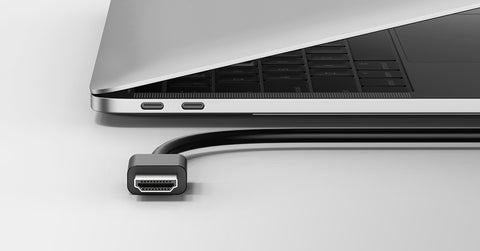
Do You Need a USB-C Hub or Docking Station?
If you think your laptop doesn't have enough ports, you want to connect to an external monitor, move files around at high speed, or just wish you had more freedom to get more done with your laptop, then you probably need a USB-C hub or docking station.
Now, if you don't know what they are, keep reading.
What is a USB-C Hub/Docking Station?
With laptops getting thinner and thinner, and the number of ports decreasing, this is something that more and more people need.
Take the MacBook Air (2020) as an example. It's only equipped with 2 USB-C ports and 1 Audio jack. When one of the USB-C ports is charging, you only have 1 USB-C port left to play with.
Not only that, when you need to connect an external display with a non-USB-C interface (such as VGA or HDMI), one USB-C port won't do you any good.

USB-C hubs and docking stations let you expand a single laptop port into multiple ports. These ports can be anything from HDMI, USB-A, SD/microSD card slots, AUX jacks, and more.

What Can They Do?
Check out some of the key functions of USB-C hubs and docking stations below:
1. Media Display
In order to improve work efficiency, many people will connect their laptop to a larger external display and display the contents on the large display.
But if your laptop doesn't have an HDMI port, you're basically stumped.
Luckily, a USB-C hub or docking station can solve your problem.

Of course, the maximum resolution and the number of displays supported will vary based on your laptop, your monitor, and which hub or docking station you use. To find out more about setting up an external monitor or monitors, take a look at our guide here.
If you're looking for a ready-to-go solution to your display issues, check out PowerExpand 11-in-1 USB-C PD Hub. This USB-C hub can connect to 2 external monitors and support dual 4K display—perfect for use in the office or while working at home.

2. Laptop Charging
A lot of adapters and simple hubs on the market don't support charging for your laptop. This means that you have to use one port for the hub, and use the other port to connect your laptop's charger.

If you always use your laptop in the same place, it's not such a big deal. But if you need to move your laptop around, take it to meetings or from room to room, it's a pain to have to keep plugging and unplugging each time. Not to mention the damage that constant wear and tear could be doing to your laptop ports.
With a USB-C hub with Power Delivery pass-through charging, you can just plug your laptop's charging cable into the hub's PD input port. This not only allows you to do everything with one port, but it also means you can easily unplug both the hub and your charger in just one easy step.

3. Data Transfer
If you do a lot of graphic design, photography, or video editing, you know it's key to be able to transfer files at high speed.
Whether you need to connect a USB-C external hard drive, a USB thumb drive, or an SD card, you can find a USB-C hub or docking station to do all of that.
One such example is PowerExpand 8-in-1 USB-C PD 10 Gbps Data Hub which supports file transfer via USB-C, USB-A, as well as SD and microSD card slots.

4. So Much More
In addition to the 3 things mentioned above, USB-C hubs and docking stations come in all shapes and sizes and with a huge variety of interfaces. Whether you need to connect peripherals, hook up some speakers, or get a stable ethernet connection, we've got a hub or docking station that can do it.
To find the perfect USB-C hub or docking station for you, try taking our quiz to get some tailored recommendations.
You can also compare the features of 4 of our most popular hubs and docking stations below.














